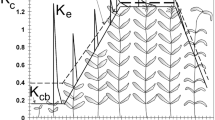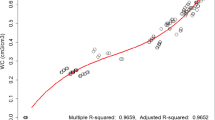Abstract
Selecting a vegetation layer design goes along with determining its future irrigation need. Therefore, it is essential to take a design decision that is minimising the cumulated construction and irrigation costs in a given depreciation period. This contribution showcases a decision support approach using long term weathering time series and soil water balances with example data for turf soccer fields in six German regions. The approach relies on minimising both material and irrigation costs by modifying soil layer design parameters; here the layer thickness and therefore its water retention capacity. E.g. suggested layer thicknesses between 200 and 250 mm for Stuttgart lead over 10–40 year depreciation periods to estimated substrate and water cost savings between 90 and 194% in comparison to a standard substrate layer thickness of 80 mm. For practical applications, the presented theoretical approach needs to be adapted with the usable soil water storage capacity and relationships describing evapotranspiration for given substrate-turfgrass combinations.







Similar content being viewed by others
Notes
Textile structures do feature capillary properties that may complement those of vegetation layers: e.g. adsorption volumina of 100–1000 mass% or capillary rise levels up to 50 cm and more with comparatively high hydraulic conductivity values are common material properties for nonwovens designed as fluid absorbers (Maschler et al. 2016). Hence, these materials do form interesting aggregates for soil substrates, as their hydraulic conductivity is much higher than in soil substrates (Kaya et al. 2017).
p. 92 gives further specific construction and irrigation recommendations.
Schlesiger et al. (2017).
For optimal substrate mixtures, see e.g. Yin et al (2012).
See e.g. Zotarelli et al (2010).
See https://www.dwd.de/DE/leistungen/cdcftp/cdcftp.html; accessed on 09 March 2018.
See ftp://ftp-cdc.dwd.de/pub/CDC/derived_germany/soil/daily/recent/derived_germany_soil_daily_recent_stations_list.txt; accessed on 09 March 2018.
See ftp://ftp-cdc.dwd.de/pub/CDC/derived_germany/soil/daily/recent/DESCRIPTION_derivgermany_soil_daily_recent_en.pdf; accessed on 09 March 2018.
The time series is for Bernburg/Saale, CDC station index 445, 84 m above mean sea level, latitude 51.82°, longitude 11.71° in Saxony-Anhalt, from 31/03/2017 to 30/09/2017.
Equations (5) and (6) in Table 2.
The authors forego listing the usage of time in the stock-flow models for reasons of simplicity.
Typically ≥ 60 mm/h according to DIN 18035-4:2012-02, p. 10, Table 3.
The main modelling entities do form stocks (state variables, boxed) that are connected with flows (double-lined arrows with valve symbols), representing their rates of change. Auxiliary variables (start and end points single-lined input/information arrows) are used to calculate dependent values, whereas constants and lookup tables provide fixed scalar and vectorial data (starting point for input arrows). Sources and drains do represent state variables with an arbitrary, infinite value (represented as cloud symbols). Stock-flow models can be mapped directly on nonlinear differential equation systems. See e.g. Sterman (2001, 2002a, b).
The \( \hbox{max} \left( {a_{1} ; \ldots ;\, a_{i} ; \ldots ;\, a_{n} } \right) \) function returns the biggest of its arguments \( a_{i} \). Here, its role in (4) forms restricting \( x_{i} \) to \( x_{i} \in {\mathbb{R}}_{0}^{ + } \).
Unit conversion: \( {\text{mm}} \cdot \frac{\text{t}}{{{\text{m}}^{ 3} }} \cdot \frac{{1\,{\text{m}}_{{{\text{H}}_{2} {\text{O}}}}^{3} }}{\text{t}} = \frac{\text{m}}{1000} \cdot \frac{\text{t}}{{{\text{m}}^{ 3} }} \cdot \frac{{1000\, {\text{l}}}}{\text{t}} = \frac{\text{l}}{{{\text{m}}^{2} }} \).
There are quite better software environment choices for implementing the simulation and the cost model, as input and output data, the models and its documentation should be maintained, separately—especially in Decision Support Systems. Here, Microsoft Excel® 2010 was chosen to keep the barriers to entry on a simple level for planners and designers.
The CDC weather station identifier is 4931, Stuttgart-Echterdingen, latitude 48.69°, longitude 9.22°. The values of VPGB and RSK between 01/04/2017 and 30/09/2017 were used.
All time series cover 25 a with in total 9497 values from 01/01/1992 to 31/12/2017.
The results of each task are listed in their corresponding results column.
The standard soil layer height of 80 mm corresponds to a soil water storage capacity of 13.4 l/m²; the standard soil layer height of 120 mm corresponds to a soil water storage capacity of 20.2 l/m².
Power (2001, p. 432).
Ibidem, p. 436.
Ibidem, p. 435.
Ibidem, p. 433.
References
Bianchi, L., Dorigo, M., Gambardella, L. M., & Gutjahr, W. J. (2009). A survey on metaheuristics for stochastic combinatorial optimization. Natural Computing, 8(2), 239–287.
Boussaïd, I., Lepagnot, J., & Siarry, P. (2013). A survey on optimization metaheuristics. Information Sciences, 237, 82–117.
Cong, Z., Hua-fang, L., & Guang-heng, N. (2014). A simplified dynamic method for field capacity estimation and its parameter analysis. Water Science and Engineering, 7(4), 351–362.
DEStatis. (2018). Wasserwirtschaft. Retrieved February 13, 2018 from http://www.destatis.de/DE/ZahlenFakten/GesamtwirtschaftUmwelt/Umwelt/UmweltstatistischeErhebungen/Wasserwirtschaft/Tabellen/Entgelt_Trinkwasserversor_Tarifgeb_nachTariftypen2014_2016_Land_Bund.html.
DIN – Deutsches Institut für Normung e.V. (2003). DIN 18035-2:2003-07: Sportplätze Teil 2: Bewässerung. Normausschuss Bauwesen (NABau), ICS 97.220.10, Beuth.
DIN – Deutsches Institut für Normung e.V. (2012). DIN 18035-4:2012-02: Sports grounds—Part 4: Sports turf areas. Berlin: Beuth.
FLL Forschungsgesellschaft Landschaftsentwicklung Landschaftsbau e.V. (2008). Golfplatzbaurichtlinie – Richtlinie für den Bau von Golfplätzen.
Haude, W. (1954). Zur praktischen Bestimmung der aktuellen und potentiellen Evaporation und Evapotranspiration. Schweinfurter Dr. und Verlag-Ges.
Kaicun, W., & Dickinson, R. E. (2012). A review of global terrestrial evapotranspiration: Observation, modeling, climatology, and climatic variability. Reviews of Geophysics, 50, 2.
Kaya, C., Maschler, T., Stegmaier, T., Baader, P., Schweizer, I., Morhard, J. et al. (2017). RasenTex – Entwicklung neuartiger Vegetationstragschichtsysteme für Rasenflächen zur Intensivnutzung aus regional verfügbaren, nachhaltigen Substratkomponenten. ZIM Co-operation Project ZF4060029AW7. Retrieved March 09, 2018 from http://www.rasentex.de/.
Klapproth, A. (2017). Wassersparkonzepte für den Sportrasen. Ansätze für einen ressourcenschonenden Umgang. Presentation on the Osnabrücker Sportplatztage 2017. Retrieved May 18, 2018 from https://www.hs-osnabrueck.de/fileadmin/HSOS/Homepages/ILOS/pdf/2017-07-Wassersparkonzepte_auf_Sportanlagen-Osnabrueck_Rasentage.pdf.
Löpmeier, J. F. (2014). Agrarmeteorologisches Modell zur Berechnung der aktuellen Verdunstung (AMBAV). Retrieved May 07, 2018 from ftp://ftp-cdc.dwd.de/pub/CDC/derived_germany/soil/daily/recent/AMBAV.pdf.
Maschler, T., Gulich, B., Reichel, S., & Matheis, M. (2016). Forschungsbericht zum Vorhaben IGF/AiF 16828 BG „Einzelfasercharakterisierung bezüglich ihrer Verarbeitbarkeit zu Vliesstoffen und der resultierenden Produkteigenschaften“. Available at Sächsisches Textilforschungsinstitut Chemnitz (STFI) and DITF.
Michael, T., Domdey, C., Reitmeyer, I., Richter, B., & Schlimm, R. (2015). Diercke Weltatlas (1st ed.). Braunschweig: Westermann Schroedel Diesterweg Schöningh Winklers GmbH. ISBN 978-3-14-100800-5 (print A4 in 2017).
Monteith, J. L. (1965). Evaporation and environment. In Symposia of the society for experimental biology (Vol. 19, No. 205–23, p. 4).
Murray, C., Peel, M. C., Finlayson, B. L., & McMahon, T. A. (2007). Updated world map of the Köppen–Geiger climate classification. Hydrology and Earth System Sciences Discussions, 4(2), 439–473.
O’Brien, P., & Oatis, D. A. (2018). Successful putting green construction starts with planning. Putting green construction projects must account for playability goals, agronomic requirements, and budgetary considerations. USGA Green Section Record, 65(5), March 2, 2018. Retrieved March 09, 2018 from http://gsrpdf.lib.msu.edu/ticpdf.py?file=/article/o%27brien-oatis-successful-3-2-17.pdf.
Penman, H. L. (1948). Natural evaporation from open water, bare soil and grass. In: Proceedings of the royal society of London A (pp. 120–145). The Royal Society.
Power, D. J. (2001). Supporting decision-makers: An expanded framework. In Proceedings of informing science and IT education.
RAL – Deutsches Institut für Gütesicherung und Kennzeichnung e.V. (2013). RAL-GZ515-2, July 2013: Werkseitig hergestellte Rasentragschichtgemische und Baustoffgemische für Drainschichten für Sportplätze.
Schlesiger, G., Snowadsky, R., Baader, P., Ulenberg, A., Trojahn, K., & Klein, W. (2017). Sportplatzbau und- erhaltung. Deutscher Fußball-Bund e.V., 5. überarbeitete Auflage, 2017. Retrieved February 13, 2018 from https://www.dfb.de/fileadmin/_dfbdam/11973-Sportplatzbau_gesamt_01.pdf.
Sterman, J. D. (2001). System dynamics modeling: Tools for learning in a complex world. California Management Review, 43(4), 8–25.
Sterman, J. D. (2002a). All models are wrong: Reflections on becoming a systems scientist. System Dynamics Review, 18(4), 501–531.
Sterman, J. D. (2002b). System Dynamics: systems thinking and modeling for a complex world. https://dspace.mit.edu/bitstream/handle/1721.1/102741/esdwp-2003-01.13.pdf?sequence=1. Accessed 26 Sept 2019.
USGA Green Section Staff. (2017). USGA recommendations for a method of putting green construction. USGA Green Section Record, 56(4), 16 February 2017.
Wallach, D., Makowski, D., Jones, J. W., & Brun, F. (2014). Working with crop models—Simulation with dynamic system models. In D. Wallach, D. Makowski, J. W. Jones & F. Brun (Eds.), Working with dynamic crop models. Methods, Tools and examples for agriculture and environment (2nd ed., pp. 119–157), ISBN: 978-0-12-397008-4. https://doi.org/10.1016/B978-0-12-397008-4.00004-6.
Yin, S. H., Chang, Z. H., Han, L. B., & Lu, X. S. (2012). Study on optimization of moisture retention for golf green rootzone soil mixtures. Acta Ecologica Sinica, 32(1), 26–32.
Zhao-Liang, L., et al. (2009). A review of current methodologies for regional evapotranspiration estimation from remotely sensed data. Sensors, 9(5), 3801–3853.
Zotarelli, L., Dukes, M. D., & Morgan, K. T. (2010). Interpretation of soil moisture content to determine soil field capacity and avoid over-irrigating sandy soils using soil moisture sensors. University of Florida Cooperation Extension Services, AE460, 2010. Retrieved May 24, 2018 from http://hos.ufl.edu/sites/default/files/extension/potato/publications/Interpretation%20of%20Soil%20Moisture%20Content%20-%20Zotarelli.pdf.
Author information
Authors and Affiliations
Corresponding author
Additional information
Publisher's Note
Springer Nature remains neutral with regard to jurisdictional claims in published maps and institutional affiliations.
Rights and permissions
About this article
Cite this article
Maschler, T., Stürmer-Stephan, B., Morhard, J. et al. A decision support method for designing vegetation layers with minimised irrigation need. Ann Oper Res 314, 577–600 (2022). https://doi.org/10.1007/s10479-019-03401-0
Published:
Issue Date:
DOI: https://doi.org/10.1007/s10479-019-03401-0




